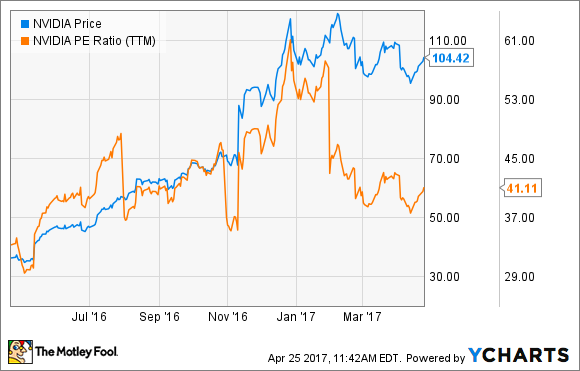NVIDIA (NVDA 0.56%) reports its fiscal 2018 first-quarter earnings on Tuesday, May 9. Expectations are riding high after a year in which revenue increased 38% to $6.9 billion, driving earnings per share 83% higher to $3.06. The coming quarters will be crucial for NVIDIA to show investors it can deliver sustainable growth in the face of greater competition. Here's what investors need to know.
Recent trends
NVIDIA turned in another impressive quarter when it reported fiscal fourth-quarter results in February. Rapid adoption of NVIDIA's graphics processing unit (GPU)-based computing solutions powered strong revenue growth of 55% year over year to $2.17 billion, beating management's own guidance of $2.1 billion. On a non-GAAP basis, the graphics company posted $1.13 in earnings per share, representing growth of 117% over the prior-year period.

NVIDIA GTX 1080 Ti gaming GPU. IMAGE SOURCE: NVIDIA INC.
Analysts expect NVIDIA's momentum to continue for the 2018 fiscal first quarter. Revenue is expected to grow 46% over the prior-year period to $1.91 billion, and earnings are expected to more than double to $0.67 per share year over year. This outlook will be driven by continued growth in the company's gaming and data-center segments.
Looking forward
Data-center revenue was only 13% of total revenue in the fiscal fourth quarter, but with its recent growth rate around 200%, the data-center business is well on pace to be as important to the company's top line as the gaming segment. Companies across several industries are adopting GPU-powered deep-learning computing solutions, which is fueling the growth in data-center revenue. NVIDIA is partnered with several major tech companies, including Microsoft and Facebook, that position it well for continued growth. In total, there are over 19,000 companies using NVIDIA technology for deep learning.
Gaming revenue was 62% of the company's total in the previous quarter, so it's still the most important contributor to NVIDIA's year-over-year revenue growth. The gaming segment is seeing strong growth as PC gamers around the world are upgrading older GPUs to the new Pascal-based GPUs. There are about 200 million gamers who use NVIDIA's GPUs for PC gaming around the world. On the fiscal 2017 fourth-quarter earnings conference call, CEO Jensen Huang said:
It takes about three to four years to upgrade the entire installed base. And we started ramping Pascal ... a few quarters ago. And our data would suggest that the upgrade cycle is going well, and we have plenty to go.
To nudge these gamers along the upgrade cycle, NVIDIA recently launched the new GTX 1080 Ti gaming graphics card, which the company touted as the most powerful gaming card on the market. The GTX 1080 Ti gives the company some wiggle room to navigate around the upcoming competition, when Advanced Micro Devices (AMD 0.55%) ups the ante with its new Vega GPU.
AMD is expected to launch its new Vega graphics card sometime before the end of June. NVIDIA is the current market-share leader, having shipped 70% of discrete GPUs in the fourth quarter of 2016. This situation is no doubt prodding AMD to fight back.
It's possible AMD's new Vega GPU could outperform NVIDIA's GTX 1080 Ti. If so, look for NVIDIA to take advantage of its superior financial position to fight AMD off with lower prices on its GPUs.
What's at stake
NVIDIA's stock has soared 180% over the past 12 months as investors have gotten excited about the company's growth potential -- not only in gaming, but also in non-gaming areas as companies adopt GPUs to power deep-learning computing applications and self-driving cars. It may be a few years before NVIDIA begins to gain significantly from the self-driving-car industry, so investors should focus on how well the gaming and data-center segments perform in the coming quarters.
With the stock trading at a high P/E ratio after its huge run, all attention will be focused on what management has to say about the future. NVIDIA will have to continue delivering impressive growth, such as we've seen in the past few quarters, to justify the stock's current valuation.








